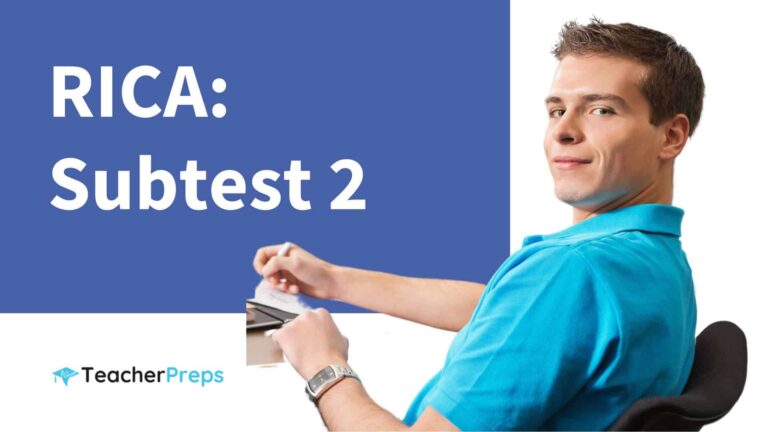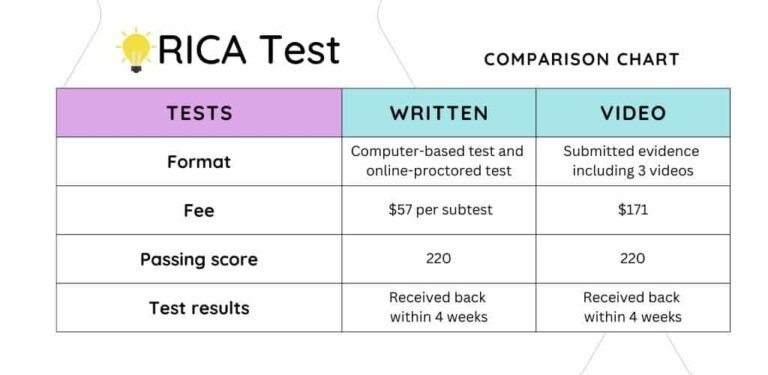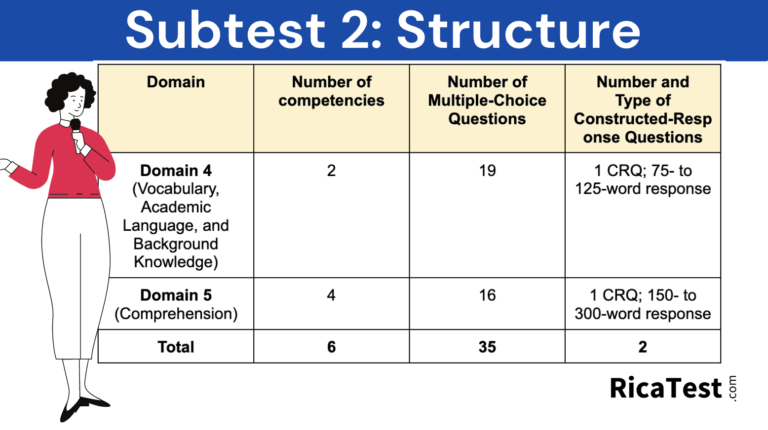RICA Subtest 2
Welcome! Are you looking to learn more about RICA Subtest 2? If so, you’ve come to the right place!
RICA Subtest 2, also known as the Reading Instruction Competence Assessment, is a critical component of the California Reading Specialist Credential.
This subtest measures a candidate’s knowledge and skills in the area of reading assessment and instruction. It is designed to assess a candidate’s ability to analyze and interpret various types of reading assessments, as well as to design and implement appropriate reading instruction based on assessment results.
Candidates must pass RICA Subtest 2 in order to earn their credential, and it is an important step in becoming a qualified educator in the state of California.
Feel 100% prepared with our test prep!

General Information
Overview
The RICA is an assessment used by the California Commission on Teacher Credentialing to measure a teacher‘s knowledge, skill, and ability in delivering effective reading instruction. It ensures that candidates for Multiple Subject Teaching Credentials and Education Specialist Instruction Credentials possess the necessary skills for providing such instruction.
The RICA Content Specifications are organized into five domains:
- Domain 1: Planning, Organizing, and Managing Reading Instruction Based on Ongoing Assessment
- Domain 2: Word Analysis
- Domain 3: Fluency
- Domain 4: Vocabulary, Academic Language, and Background Knowledge
- Domain 5: Comprehension
Types Of Assessments
The RICA Test includes two different types of exams. There is the written examination and the video assessment.
The written exam is the most popular exam, and it includes 3 separate subtests which cover a variety of factors regarding reading instruction.
Have a look at the chart below to better understand the difference between RICA written exam and the video assessment.

Subtest 2 Structure
As we can see from the image below, Rica Subtest 2 consists of domains 4, Vocabulary, Academic Language, and Background Knowledge, and domain 5, Comprehension.
While taking Subtest 2, you will receive a total of 35 multiple-choice questions and two essay prompts. One essay prompt requires a written response of between 150 – 300 words, and one response requires a written response of between 75 – 125 words.

Subtest 2 Content Specifications
There’s a lot of information to remember to pass your RICA exam.
Important areas to focus on include the following:
Competency 10: Understand the role of vocabulary, academic language, and background knowledge in reading development and factors that affect students' development of vocabulary, academic language, and background knowledge.
I. Introduction
- Domain 4: Vocabulary, Academic Language, and Background Knowledge
- Competency 10: Understand the role of vocabulary, academic language, and background knowledge in reading development and factors that affect students’ development of these
II. The Role of Vocabulary, Academic Language, and Background Knowledge in Reading Development
- Vocabulary knowledge in word recognition and fluency
- Vocabulary knowledge and reading comprehension
- Academic language and reading comprehension
- Background knowledge and reading comprehension
- Interrelationships between vocabulary, academic language, and background knowledge
III. Important Issues Related to the Development of Vocabulary, Academic Language, and Background Knowledge
- Early vocabulary development
- The Matthew Effect and its impact on students’ growth in vocabulary, academic language, and background knowledge
- Interrelationships between vocabulary knowledge and concept learning
- Vocabulary learning as an incremental process
- The open-ended nature of vocabulary and background knowledge
IV. The Role of Text in Developing Vocabulary, Academic Language, and Background Knowledge
- The larger and more sophisticated vocabulary used in text
- The complex language structures used in text
- The importance of independent reading in developing vocabulary, academic language, and background knowledge
V. Factors to Consider in Developing Students’ Vocabulary, Academic Language, and Background Knowledge
- Evaluating the usefulness and frequency of words
- Identifying tiers of general academic vocabulary
- Understanding specialized vocabulary
- Promoting students’ word consciousness
- Reinforcing vocabulary, academic language, and background knowledge
- Providing explicit vocabulary instruction
- Providing opportunities for students to interact with and discuss text
- Providing opportunities for students to read a wide range of texts
- Providing scaffolding and support for vocabulary, academic language, and background knowledge development
- Considering students’ prior knowledge and experiences.
Competency 11: Understand how to promote students' development of vocabulary, academic language, and background knowledge.
I. Introduction
- Competency 11: Understand how to promote students’ development of vocabulary, academic language, and background knowledge
II. Research-based, systematic, explicit instruction in vocabulary
- Providing student-friendly definitions
- Providing meaningful and contextualized examples
- Examples of explicit oral and written strategies that promote integration of word knowledge and provide repeated, meaningful exposure to new academic and content-area vocabulary
III. Independent strategies for building vocabulary
- Use of contextual strategies
- Use of morphological strategies
- Use of reference materials
IV. Developing students’ word consciousness and fostering a love of words
- Examples of explicit strategies for developing word consciousness and fostering a love of words
V. Listening-comprehension activities
- Examples of explicit listening-comprehension activities that promote the development of vocabulary, academic language, and background knowledge
VI. Wide reading for building vocabulary, academic language, background knowledge, and a love of reading
- Recognition of the role of wide reading in building vocabulary, academic language, background knowledge, and a love of reading
- Examples of explicit strategies for promoting students’ purposeful independent reading of a broad range of literary and informational texts
VII. Developing students’ knowledge of language and language structures
- Examples of explicit strategies for developing students’ knowledge of language and language structures
VIII. Helping students understand similarities and differences between language structures used in spoken and written language, and developing their knowledge of written language structures and conventions
- Examples of explicit strategies for helping students understand similarities and differences between language structures used
Competency 12: Understand literal, inferential, and evaluative comprehension and factors affecting reading comprehension.
I. Understanding literal, inferential, and evaluative comprehension
- Recognizing how knowledge and skills in word analysis, fluency, vocabulary, academic language, and background knowledge affect comprehension
- Demonstrating knowledge of literal reading comprehension (e.g., identifying main ideas, details, sequences, cause-and-effect relationships)
- Demonstrating knowledge of inferential reading comprehension (e.g., inferring main ideas, comparisons, cause-and-effect relationships, drawing conclusions, predicting outcomes, inferring themes)
- Demonstrating knowledge of evaluative reading comprehension (e.g., recognizing bias, unsupported assumptions, propaganda, faulty reasoning, distinguishing facts and opinions, reacting to text content, characters, language, analyzing themes)
II. Factors affecting reading comprehension
- Recognizing the role of syntax in facilitating or impeding comprehension
- Recognizing the role of text structures in facilitating or impeding comprehension
- Demonstrating knowledge of the relationship between oral language and reading comprehension
- Recognizing the role of listening comprehension in developing reading comprehension skills
- Recognizing the role of text-based discussions in enhancing comprehension
- Recognizing the role of writing activities in supporting and reinforcing reading comprehension skills
- Recognizing the importance of independent reading in reinforcing reading comprehension skills and strategies.
III. Role of phonics and sight words in reading development
- Accurate, automatic word identification
- Word recognition and reading fluency
- Word recognition and comprehension
IV. Terminology and concepts related to phonics instruction
- Types of consonant sounds
- Common letter combinations
- Inflected morphological units
- Word patterns of increasing difficulty
- Syllable patterns and syllabication
- Phonetically irregular and decodable words
- Sight words until phonetic pattern is taught
V. Decoding and encoding as reciprocal skills
- Interrelationships between phonics and spelling/orthographic development
- Stages of spelling development and implications for instruction
- Writing activities and applying phonics knowledge in context
Competency 13: Understand how to facilitate reading comprehension by providing instruction that prepares students for the reading task, scaffolds them as needed through the reading process, and prepares them to respond to what they have read.
I. Understanding reading comprehension
- Recognize how a reader’s knowledge and skills in word analysis, fluency, vocabulary, and academic language and the reader’s background knowledge affect comprehension
- Demonstrate knowledge of literal, inferential, and evaluative reading comprehension
- Recognize the role of syntax, text structures, oral language, and listening comprehension in reading comprehension
- Recognize the role of text-based discussions and writing activities in enhancing comprehension
- Recognize the role of independent reading in reinforcing reading comprehension skills
II. Facilitating reading comprehension through instruction
- Demonstrate knowledge of explicit instructional strategies for orienting students to new texts, supporting comprehension during reading, and supporting comprehension after reading
- Demonstrate knowledge of explicit instructional strategies for promoting students’ development of listening comprehension skills and transferring comprehension strategies from oral language to written language
- Demonstrate knowledge of addressing the full range of learners in the classroom with respect to facilitating reading comprehension
- Demonstrate knowledge and ability in assessment of reading comprehension, including students’ use of comprehension strategies
- Demonstrate knowledge of explicit instructional strategies for supporting the development of students’ comprehension of complex texts, including literary texts and informational texts
Competency 14: Understand how to promote students' comprehension and analysis of narrative/literary texts and their development of literary response skills.
- Demonstrate knowledge of explicit instructional strategies for helping students recognize the organizational structure and key characteristics of major literary genres (e.g., poetry, drama, prose)
- Demonstrate knowledge of elements of story grammar and other key elements of narrative/literary texts, and explicit instruction in these elements
- Demonstrate knowledge of research-based, systematic, explicit instruction in narrative analysis and literary criticism, including explicit instructional strategies for analyzing and responding to narrative/literary texts (e.g., plot, characters, setting, theme, literary devices)
- Demonstrate knowledge of explicit oral language activities (e.g., literature circles, questioning the author) that develop and reinforce students’ comprehension and analysis of narrative/literary texts
- Demonstrate knowledge of explicit writing activities (e.g., literary response journals) that develop and reinforce students’ comprehension and analysis of narrative/literary texts
- Demonstrate knowledge of how to address the full range of learners in the classroom with respect to their comprehension and analysis of narrative/literary texts (e.g., struggling readers, students with special needs, English learners, advanced learners)
- Demonstrate knowledge and ability in assessment of students’ comprehension and analysis of narrative/literary texts
- Recognize the importance of providing a rich literature program that exposes students to a diverse range of authors, cultures, and literary works.
Competency 15: Understand how to promote students' comprehension of expository/informational texts and their development of study skills and research skills.
- Demonstrating knowledge of instructional strategies for helping students recognize key characteristics of various expository/informational materials.
- Demonstrating knowledge of instructional strategies for promoting students’ comprehension of expository/informational texts through understanding common text structures and attention to transition words and other features.
- Demonstrating knowledge of instructional strategies for helping students recognize and use text features that support comprehension of expository/informational texts.
- Demonstrating knowledge of instructional strategies for promoting students’ comprehension of expository/informational texts, including analyzing an author’s argument and generalizing knowledge learned from texts.
- Demonstrating knowledge of oral language activities that develop and reinforce comprehension of expository/informational texts and related vocabulary, language, and background knowledge.
- Demonstrating knowledge of writing activities that develop and reinforce comprehension of expository/informational texts.
- Demonstrating knowledge of instructional strategies for promoting students’ development of study skills and research skills, including locating and retrieving information and using technology to manage information.
- Demonstrating knowledge of how to provide differentiated instruction for students with a range of needs in these areas, including struggling readers and students with disabilities, special needs, English language learning needs, and advanced learners.
- Demonstrating knowledge and ability in assessment of comprehension of expository/informational texts and development of study skills and research skills.
